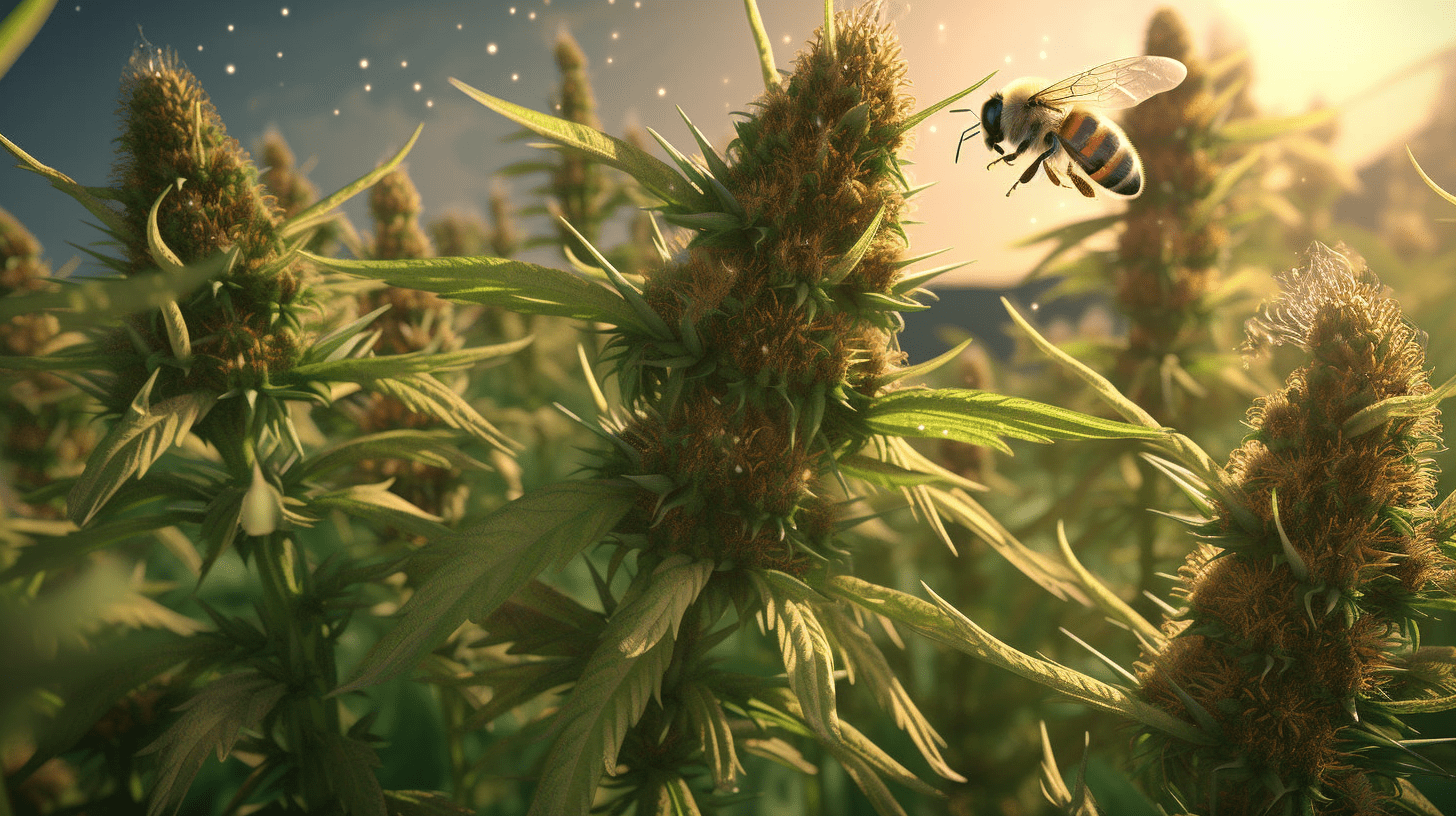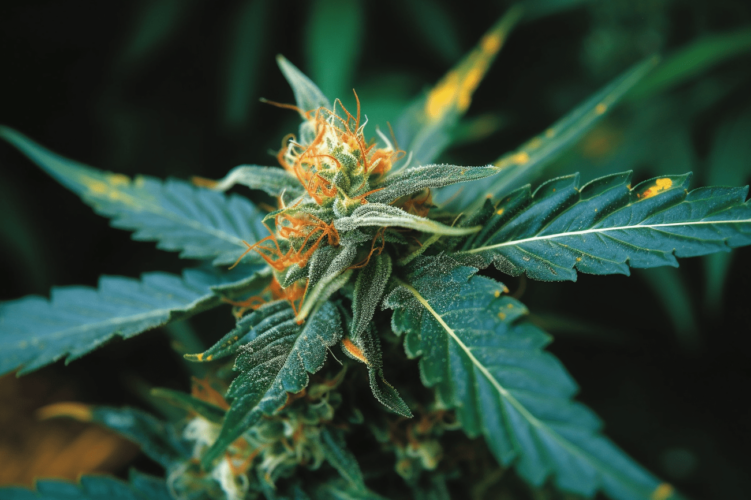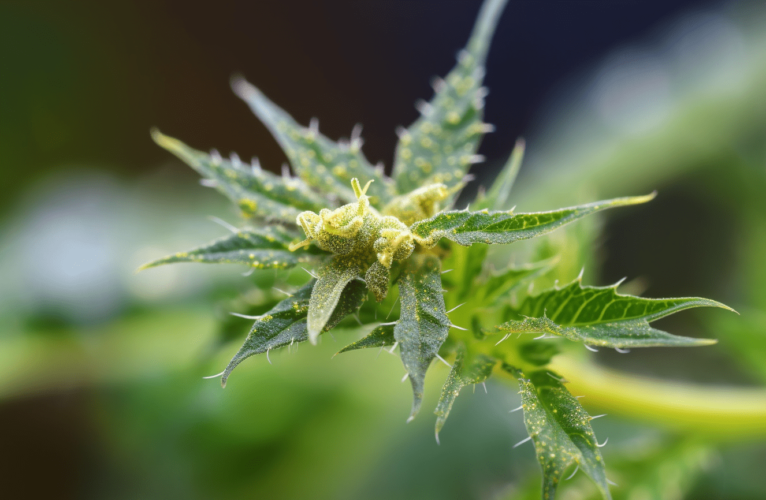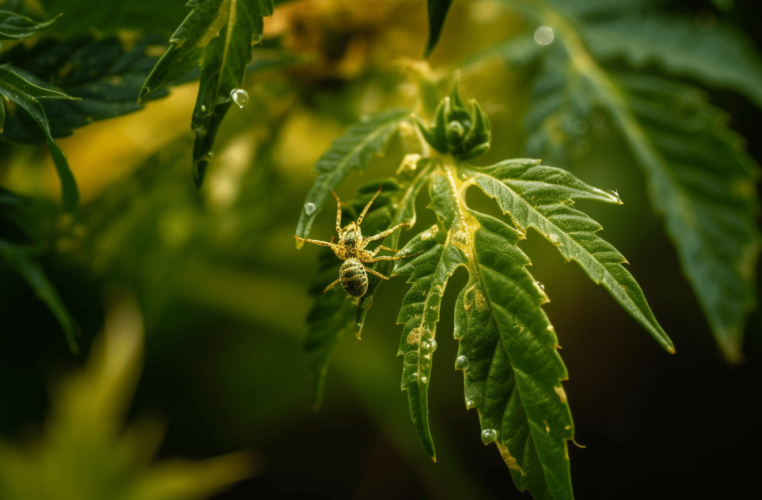
Integrated pest management for cannabis cultivation is a natural approach to controlling pests and ensuring healthy, high-quality harvests. By utilizing an IPM program in your grow space, you can reduce the need for chemical pesticides while still keeping pests at bay. This article examines the concept of IPM and its advantages for cannabis production, lists usual pest issues in growing areas, and gives guidance on applying efficient IPM techniques. Finally we’ll look at monitoring & evaluating these programs to ensure successful results.
Table of Contents:
- Introduction to Integrated Pest Management (IPM) for Cannabis Cultivation
- Common Pests Found in Cannabis Cultivation
- Implementing an Effective IPM Plan
- Monitoring Your Plants with AI Technology
- Best Practices When Using Pesticides
- Compliance Considerations For Cannabis Growers
- FAQs in Relation to Integrated Pest Management for Cannabis Cultivation: a Natural approach to Pest Control
- Conclusion
Introduction to Integrated Pest Management (IPM) for Cannabis Cultivation
Integrated pest management (IPM) is a technique for controlling pests in cannabis cultivation that encompasses physical, biological and chemical measures to limit the population of unwanted insects. IPM involves a mix of physical, biological and chemical techniques to reduce the amount of pests present in the cultivation environment. IPM works by setting limits on the population of pests that can exist before action must be taken to control them. This helps growers maintain healthy plants while minimizing their use of chemical pesticides and other harmful products.
The first step in implementing an effective IPM program for cannabis cultivation is sanitation. Growers should practice good hygiene when handling incoming plants or materials, as this will help prevent the spread of disease-causing organisms such as fungus gnats or spider mites. Additionally, it’s important to regularly clean and disinfect grow rooms to eliminate any existing pest populations before they become a problem.
Physical barriers are also key components of successful IPM programs for cannabis growers. Using screens on windows and doors can help keep out unwanted visitors like birds or rodents that may bring in new diseases or insects with them from outside sources. Additionally, plastic sheeting can be used around soil beds to create an additional layer of protection against potential infestations from nearby areas where pests may already exist.
AI has become increasingly popular among farmers as it can detect problems quickly, helping them to be proactive in avoiding potential risks. This type of system can alert you if there’s an unexpected surge in certain types of insect activity within your grow room, giving you a heads up so that you can take swift action before any damage is done. By leveraging this cutting-edge technology and implementing an effective IPM plan, cannabis cultivators can ensure their crops remain healthy and pest-free. Keywords: AI Technology, Integrated Pest Management (IPM), Modern Farmers, Insect Activity
As an advanced level professional, one must always take the proper protective measures when applying pesticides as part of an IPM plan for cannabis cultivation. This includes donning gloves, goggles/glasses and a respirator mask to avoid any hazardous effects from direct inhalation or skin contact with chemicals. Furthermore, it is essential to understand re-entry intervals after pesticide application; this refers to how long one needs wait before safely entering treated areas again without risk exposure any lingering toxic residues left behind after spraying – typically 12 hours minimum is recommended but could vary depending on the product chosen. Keywords: Active Voice, Advanced Level Professional, Protective Measures, Re-Entry Intervals
Integrated Pest Management is an effective and natural approach to pest control for cannabis cultivation, allowing growers to maintain a healthy grow room without the use of traditional pesticides. Now, let’s delve into the usual bugs that are present in both indoor and outdoor cannabis grow spaces and how they can affect plant well-being.
Common Pests Found in Cannabis Cultivation
Cultivating cannabis necessitates meticulous oversight and handling to guarantee bountiful harvests. Infestations of bugs can be a very detrimental problem for cultivators, resulting in considerable losses with regards to both yield and quality. Understanding common pests found in cannabis cultivation is essential for preventing costly damage and crop loss.
A variety of pests, including fungus gnats, aphids, spider mites, whiteflies, thrips, root aphids, mealybugs beetles and caterpillars as well as nematodes can infest both indoor and outdoor cannabis grow rooms. All of these insects feed on the plant’s leaves or roots causing discoloration or wilting of the foliage as well as stunted growth. In addition to direct feeding damage from insects there are also diseases spread by certain insect species such as powdery mildew which can cause severe leaf distortion if left unchecked.
Sanitation is key to preventing pest problems before they become a major issue. To that end, it’s important to regularly clean grow room surfaces with approved disinfectants such as hydrogen peroxide or bleach solutions and be mindful of incoming plants brought into the cultivation area from outside sources. As a last resort, chemical pesticides should only be used sparingly due to their potential harm to beneficial organisms in soil systems like earthworms and predatory mites which help keep pests in check naturally.
When it comes time for identifying possible pests early on, it is important to inspect plants regularly for signs of damage caused by chewing insects or yellowing/discolored spots which could indicate fungal infection spread by certain insect species like fungus gnats. If you do notice any suspicious activity, take action quickly before an infestation spreads throughout your entire crop cycle resulting in major losses at harvest time.
It is important to understand the common pests found in cannabis cultivation, as this knowledge can help you create an effective Integrated Pest Management plan. By implementing sanitation practices, physical barriers and biological control options for natural pest management, growers can ensure their plants remain healthy and free from unwanted visitors.

Implementing an Effective IPM Plan
Integrated Pest Management (IPM) is a sustainable solution for managing pests in cannabis cultivation that involves utilizing preventive techniques and biological controls. It relies on a combination of preventative measures, such as sanitation practices and physical barriers, as well as biological controls like beneficial insects. By implementing an IPM plan, growers can reduce the need for chemical pesticides while still keeping their crops healthy.
Maintaining cleanliness is essential for avoiding pest issues. Growers should regularly clean their grow rooms and equipment to remove any potential food sources for pests. They should also check incoming plants for signs of infestation before bringing them into the cultivation area. This will help keep pest populations at bay throughout the crop cycle.
Physical barriers are another important part of an IPM plan. Growers can use screens or mesh covers over windows and doors to keep out unwanted visitors like rodents or birds that may be carrying pests with them into the grow room environment. They can also set up sticky traps around areas where pests might enter from outside, such as air vents or cracks in walls or floors.
Introducing predatory mites into the growing space is an effective way to manage fungus gnat populations without resorting to chemical pesticides that could harm other beneficial organisms living in the grow room. Additionally, some growers have had luck with planting insect-attracting plants nearby their gardens, thereby luring helpful insects which prey on common garden pests instead of harmful ones. Utilizing these strategies can help maintain a healthy crop cycle while keeping pest populations at bay.
By combining preventive measures with biological controls, growers can create a safe and effective IPM program that helps protect their crops from damaging pest infestations while reducing environmental impacts associated with chemical pesticide use. This approach is advantageous for both the cultivator and nature, offering a viable method to manage nuisances without depending on conceivably damaging synthetics.
Executing a viable IPM strategy is critical for successful cannabis cultivation, as it can help decrease the danger of pest invasions and diseases. AI technology has become increasingly important in modern-day agriculture due to its ability to monitor plants more efficiently than manual methods; therefore, exploring this topic further can provide beneficial insight into natural pest management strategies.
Monitoring Your Plants with AI Technology
AI technology has revolutionized modern-day agriculture, and cannabis cultivation is no exception. AI-powered systems offer growers the ability to monitor their plants more effectively than ever before. These systems can detect issues such as disease or pest infestations early on, allowing for quick action and prevention of major problems down the line.
The advantages of using an AI system compared to manual methods are numerous. For starters, they provide a much higher level of accuracy in detecting problems quickly and accurately. Additionally, they allow growers to set pest limits within their cultivation area so that any increase in pests will be noticed immediately. This allows them to take corrective action faster than if they were relying solely on manual monitoring techniques.
An AI-powered system can detect the presence of fungus gnat eggs or larvae in incoming plants, alerting the grower to take preventative measures before they are introduced into the grow room environment and have a chance to spread like wildfire throughout the entire operation. Growers can preemptively tackle any potential problems before they become a problem by using this AI-driven system.
In addition to providing more accurate detection capabilities, an AI system also helps reduce reliance on chemical pesticides which can have negative impacts on both plant health and human safety when used improperly or overused too often. Instead, it encourages growers to use biological controls whenever possible while still keeping pest populations under control through proper sanitation practices and physical barriers around their facility’s perimeter walls or other entry points for unwanted visitors like rodents or birds.
AI tech can be a great aid in tracking your plants, allowing for the rapid detection and avoidance of any pest issues. With proper implementation, this can be an effective tool for keeping your cannabis cultivation safe from harm. Next, we will look at the best practices when using pesticides in order to protect both yourself and your crops.

Best Practices When Using Pesticides
When employing pesticides as a final option for pest control in cannabis growth, it is essential to observe proper procedures. Proper personal protective equipment (PPE) must be worn when handling any chemical pesticides and the re-entry intervals must be followed carefully. PPE includes items such as gloves, long pants and sleeves, eye protection, and respirators or masks. Re-entry intervals refer to the amount of time that needs to pass after pesticide application before people can safely enter the area again without risk of exposure.
It is also important for growers to set pest limits for their crop cycle based on their own thresholds for acceptable levels of damage from pests. If these limits are exceeded then an IPM program should be implemented which involves both chemical pesticides and biological controls like beneficial insects or nematodes which attack specific types of pests like fungus gnats or spider mites respectively.
Growers should also ensure that incoming plants have been inspected properly prior to being brought into the grow room in order to prevent any possible infestations from occurring due to hitchhiking pests like aphids or thrips. Regular monitoring throughout the entire crop cycle will help detect pest problems early so they can be addressed quickly before they become unmanageable, leading to potentially catastrophic losses in yield quality and quantity if left unchecked.
Marijuana growers must recognize the need for proper PPE and re-entry intervals when utilizing pesticides in order to ensure safety and adhere to regulations. To remain compliant throughout the entire growing process, it is essential that marijuana growers become familiar with applicable regulations concerning their operations.
Compliance Considerations For Cannabis Growers
When growing cannabis, it is essential that compliance regulations are followed strictly. Section 1602 of the EPA dictates that all farming, including cannabis cultivation, must abide by certain pesticide guidelines in order to avoid any potential penalties or fines from local authorities. Growers must adhere to these regulations to avoid penalties and fines from local authorities. Additionally, waste disposal and run-off from pesticides used in grow rooms must be carefully considered as well.
Growers should set pest limits for their crop cycle before planting seedlings or bringing in incoming plants. Monitoring pests throughout the crop cycle can help growers identify problems early on and take action accordingly with chemical or biological controls before pest populations get out of control. For example, if fungus gnats become a problem in a grow room, immediate action needs to be taken with an appropriate pesticide solution to prevent further damage to the plants’ health and growth rate.

FAQs in Relation to Integrated Pest Management for Cannabis Cultivation: a Natural approach to Pest Control
What is the integrated pest management approach to pest control?
It involves monitoring pests, understanding their behavior, identifying favorable environmental conditions for them, and implementing preventive measures to reduce or eliminate the need for chemical treatments. IPM emphasizes prevention through cultural practices such as crop rotation and sanitation; physical methods like trapping or netting; biological controls such as introducing beneficial insects; and judicious use of pesticides when necessary. This comprehensive approach helps protect human health while preserving natural ecosystems.
What is an all natural pest control for cannabis?
Biological methods such as introducing beneficial insects, encouraging predatory mites and employing natural predators like ladybugs can be employed to naturally control pests in cannabis plants. Biological controls such as introducing beneficial insects to the grow space, encouraging predatory mites, and using natural predators like ladybugs are all effective ways to reduce pests in an organic setting. Additionally, preventative measures such as crop rotation and good sanitation practices help create an inhospitable environment for many pests. Finally, homemade sprays made from garlic or hot peppers can also be used to deter unwanted visitors from damaging your precious plants.
1. Prevention:
This method involves taking preventive measures to reduce the risk of pests in a grow environment, such as using pest-resistant plants and avoiding overcrowding or overfeeding.
2. Monitoring:
Regularly monitoring the environment for signs of pests is an important part of integrated pest management. Checking leaves, soil, and other areas can help detect early infestations before they become too severe.
3. Biological Control:
Utilizing natural predators like ladybugs or nematodes can be effective at controlling certain types of pests without the use of chemical pesticides or insecticides.
4. Chemical Control:
When all else fails, chemical control may be necessary to eliminate more serious infestations quickly and effectively with minimal damage to beneficial organisms in the ecosystem
1. Monitor and Identify Pests:
Regularly inspect plants for signs of pest activity, such as holes in leaves or discoloration. Proper identification is essential to ensure the most effective management strategies are implemented.
2. Preventative Measures:
Take proactive steps to reduce pest populations by using physical barriers like screens, insect traps, and sticky cards; removing weeds that can harbor pests; rotating crops on a regular basis; and introducing beneficial insects into the environment to feed on pests naturally.
3. Control Tactics:
When preventive measures fail or when an infestation has already occurred, use targeted control tactics such as chemical sprays or baits specifically designed for each type of pest present in order to minimize environmental impacts while still effectively managing the population size of any given species.
Conclusion
With proper identification of pests, implementation of IPM strategies, and monitoring and evaluation programs in place, growers can ensure their plants are healthy while minimizing the use of pesticides or other chemicals. By taking an integrated approach to pest control with these steps, cannabis cultivators can create sustainable growing environments where their crops will thrive.
Take control of your cannabis cultivation and learn the natural approach to pest management with GreenBudGuru.com! Our experts will provide you with the knowledge, tools, and support needed for a successful harvest.
Originally posted 2023-03-21 17:30:00.


 James Alexander
James Alexander